The first day of the 90 Miler starts in Old Forge, heads northeast through the Fulton Chain of Lakes, into Brown’s Tract, then into Raquette Lake and down the Marion River, over the old steamboat carry into Utowanna and Eagle Lakes, and ends at Blue Mountain Lake. So the racers pass through a variety of watercourses, all of them presenting their own unique challenges.
What follows is a narrative written by Jon about the race. I will add commentary from time to time.
“Kevin and I spent the entire summer training in Thankful, forsaking our usual canoe paddles and focusing exclusively on time in the guideboat seats. Since the boat was at my house, I would concentrate on rowing solo during the week. On weekends, Kevin would row while I paddled. This gave us plenty of oar time.
We also spent a bit of time on practicing out carries. We would run with the boat on wheels.
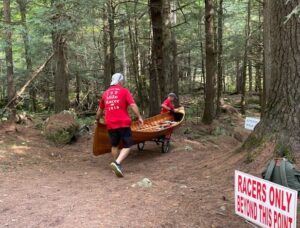
We would also switch paddle and oar stations while underway on the water. To do this, the one on the oars stands up to allow the helmsman to duck under him. The trick is for each to come up into their new seat simultaneously, while maintaining balance.”
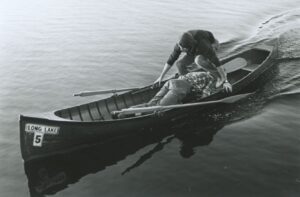
Here is an old photo of the renowned guideboat racer Howard Seaman and his son John changing positions during a race.
Jon goes on ” I must give tremendous credit to John Homer. He was a very valuable resource for us. We tried to absorb as much advice as we could from him in the month leading up to the race. John even fashioned a second pair of soft maple oars to match our primary oars. We did this in case of breakage. Race rules dictate that guideboat oars must be of the traditional fixed pin design.
For the helmsman we opted to use a bent shaft racing canoe paddle. We were more familiar with this paddle design. We felt it would give us better steering control over the entire race.”
Gordon adds:
“John Homer is a great friend of mine. John spent over 25 years in the military, proudly serving his country, sometimes in war zones. When he retired from the military, he decided to establish a business serving small wooden craft boat people. His business, called Adirondack Rowboat, Paddle and Oar {315 418 0581} is located in North Creek, NY.
John is indeed one of the cleverest people I have ever met. When he couldn’t find guideboat hardware he found out how to set=up his his own foundry and cast his own oarlocks and other hard to find hardware. Having majored in metallurgy in college, I know how difficult this is to pull off. This is just one of many examples of John’s creativity. John and his son, Dalton. also race every year in the 90 Miler. Here is John.

Thanks for serving John.
This year, 2021, the date of the 90 Miler coincided with the anniversary of 9-11. To respect that awful day, Jon and Kevin wore commemorative T-shirts. On the first day they wore red, the second, white and the third, blue shirts.
Gordon narrates:
“The first day of the race takes the racers through waterways with much history. There is the Fulton Chain noteworthy for its many hotels and hostelries back in the 1800’s. The chain starts with First Lake near Old Forge and proceeds to Eight Lake. I will talk some about the history of the Raquette Lake environs later.
Back to Jon:
“We got to the end of Fifth Lake and into the first carry. We were well in front of the pack, adding to our confidence.
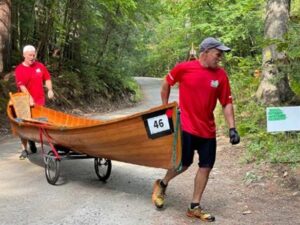
However, we knew we had to work hard to stay in front. This added to the burden of stress we were to experience over the next three days.
We didn’t do an official time trial to determine this. but it was my belief that we were faster with Kevin on the oars than myself. This is primarily due to boat trim (Kevin being about 20 pounds lighter than I). We managed the rest of the Fulton Chain quickly and efficiently, both feeling very strong.
Next, into Brown’s Tract. Brown’s Tract is a very windy, narrow, shallow stream. It provides a real challenge for racers, especially those in guideboats. Below, John Homer navigates Brown’s Tract in a single person guideboat.
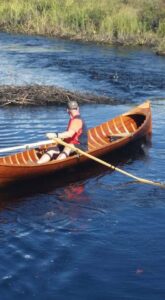
But as Jon reports “Brown’s Tract is a lot easier in a two -person configuration as the paddler (helmsman) can predict the curves and communicate with the oarsman as to when to tuck in the oars. This allows the boat to glide through a tight passage.” Jon calls Brown’s Tract “an interesting negotiation, and exercise in boat leaning and stern directional paddling.”
Another challenge faced by racers are beaver dams. Jon reports that fortunately most dams have an opening large enough to allow Thankful to pass through. With some though, you have to get out and pull the boat across.
Here is as photo of Jon and Kevin coming out of Brown’s Tract and entering Raquette Lake when they were contestants in a previous 90 Miler.
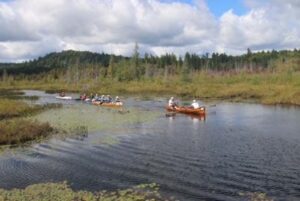
They are now in Raquette Lake, a lake known for its rich history. Back in the late 1800’s Raquette and Blue Mountain Lake were known as a mecca for the rich and famous.
Quite a number of Great Camps were built on or near Raquette Lake. William West Durant was the author of the Great Camp architectural style.
Great Camps are characterized by large compounds comprised of many separate buildings, each devoted to a separate function. Durant made clever use of natural materials, like twigs, to embellish the appearance of his buildings.
Another avant-garde trend happened in Blue Mountain Lake. There the Prospect House was the first hotel in the world to have electric lights in every room, courtesy of Thomas Edison.
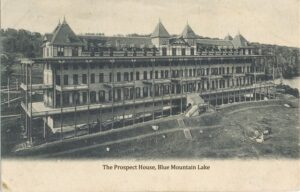
To get to this remote region, the Robber Barons of that day would arrive by overnight train from New York City. Many would be accommodated in their on private railway coach. Those headed to Blue Mountain Lake would take a steamboat down the Marion River.
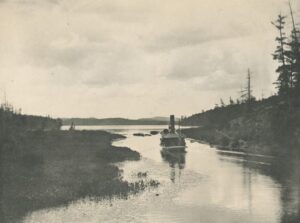
Back to the racers. Coming out of Brown’s Tract the racers cross Raquette Lake and enter the Marion River. They now retrace the path taken by the steamboats. The Marion River is full of twists and turns but wider than Brown’s Tract. This makes sense since steamboats negotiated it.
At the end of the Marion River is the Marin River Carry. The carry is about a quarter mile long and enables one to pass from Marion River to Utowanna Lake.
Back in the late 1800’s, steamboat passengers would disembark at Marion River end of the carry and climb aboard open-air railway cars. A very small steam locomotive would pull the passengers and their duffel to the other end of the carry. This narrow gauge railroad owned by the Raquette River Navigation Company, was the shortest railroad in the world at that time.
The Adirondack Museum acquired the locomotive and cars. They are on display in the Marion River Pavilion at the Museum. Here are photos of the locomotive and one of the cars.
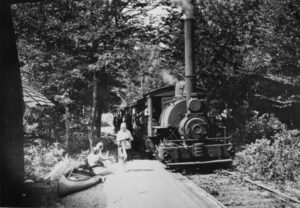
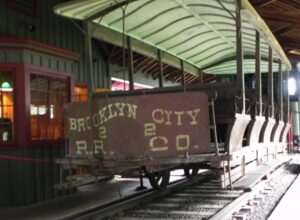
Back to the race. Racers will use the old railroad bed to carry their boats to the put-in at Utowanna Lake. They are almost home now as they pass through Utowanna and Eagle Lakes into Blue Mountain Lake.
Jon writes about traversing Blue Mountain Lake.
“The first day was characterized by massive wind-driven waves on Blue Mountain Lake. Negotiating the points means having to go parallel to the weaves periodically. This can be a bit harrowing, but Thankful handles big lumpy water very well.”
Gordon adds:
The originators of the Adirondack guideboat realized that Adirondack lakes were not always calm. In s recent 90 Miler gale force winds came whistling down Long Lake on Day 2 of the race. The canoes didn’t fare very well in the huge swells generated by the wind. Many were swamped. As I recall the guideboats were much more seaworthy and handled the heavy seas much better.
Why? Guideboats have an upward sweep along the shear line. This hinders large waves from surging over the deck and into the boat, swamping it.
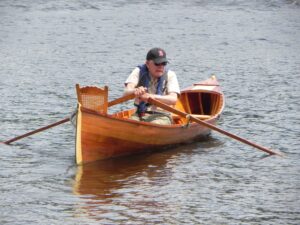
Jon and Kevin arrive at the first day’s race finish line, the Blue Mountain Lake Town Beach. They are well ahead of other 2- man guideboat racers. In fact, it will be almost twenty minutes before the next two-man guideboats appear.
Will they be able to maintain their lead? Stay tuned…